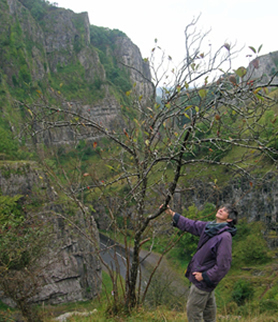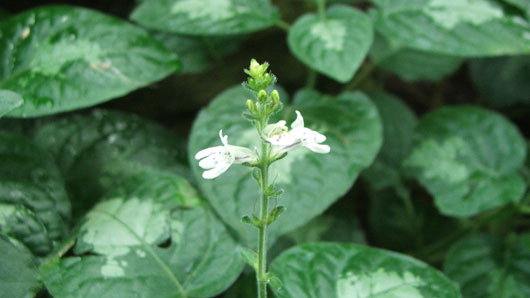UK: Three new Sorbus from Cheddar Gorge
18.12.09
The UK is not renowned for its native tree species, but it can claim three more Whitebeams (Sorbus) thanks to some cliff-hanging work by scientists from Bristol University and the National Museum of Wales (NMW).
 The discovery of the new Sorbus in Cheddar Gorge in the Mendips, Somerset may not come as a surprise to those who study these remarkable trees or landscape. The steep slopes of Cheddar are well known for populations of botanical rarities such as Dianthus gratianopolitanus, Galium fleurotii, and the Cheddar endemic Hieracium stenolepiforme.
The discovery of the new Sorbus in Cheddar Gorge in the Mendips, Somerset may not come as a surprise to those who study these remarkable trees or landscape. The steep slopes of Cheddar are well known for populations of botanical rarities such as Dianthus gratianopolitanus, Galium fleurotii, and the Cheddar endemic Hieracium stenolepiforme.
Sorbus cheddarensis pictured in Cheddar Gorge with its discoverer Libby Houston
Sorbus hybridise readily and very often these offspring are apomictic (self-fertile without pollination). This type of clonal reproduction has led to a huge number of micro-species around the world and the UK is no exception. The diversity in Cheddar, specifically, seems to be a combination of landscape changes and the presence of two more common species (S. aria and S. porretigentiformis), of which S. aria is ‘morphologically variable’ according to Dr. Tim Rich of the NMW.
Landscape changes in Cheddar saw goats introduced to control scrub, benefiting the grassland species such as Dinathus gratianopolitanus, but this in turn has led to Sorbus damage, which ‘prefer the intermediate stages of scrub succession to woodland’, and the goats have been noted grazing selectively on Sorbus during the summer months. Matching these various conservation challenges will require significant thought and efforts to get right according to the authors.
But despite the obvious vagaries of Sorbus hybridisation and populations there’s no denying they have charm and some of the best nomenclature around! S. bristoliensis is a firm favourite, but now comes the wonderful S. cheddarensis and with it S. eminentoides and S. rupicoloides (a description of the new taxa can be found in Watsonia).
Their localised distribution combined with such mega-diversity places the Sorbus in somewhat of a conservation quandary. By their very nature they are fragile, temporal things and with populations numbering only in the tens or hundreds we should enjoy the dance of their explosive speciation while we can.
If you want to go looking for more then your best bets are the Sorbus hotspots of Cheddar, the Wye Valley, Brecon Beacons, Isle of Arran and the Avon Gorge.
For the full article please see Watsonia 27: 283-300 (2009)
Related links:
Bristol University, Biological Sciences
National Museum of Wales, Biodiversity and Systematic Biology
IN PICTURES: New species from 2009
23.12.09
 In most years - globally - approximately 2,000 new plants make themselves known to science. One of the most prolific has to be the team at Kew who collectively discovered more than 250 new species in 2009.
In most years - globally - approximately 2,000 new plants make themselves known to science. One of the most prolific has to be the team at Kew who collectively discovered more than 250 new species in 2009.
UK: Hundreds of new species round-off Kew's anniversary year
22.12.09
 It's been a remarkable year for Kew, as it celebrates its 250th year, and as we enter the International Year of Biodiversity in 2010 comes news of over 250 new species discovered by botanists from the famous London garden.
It's been a remarkable year for Kew, as it celebrates its 250th year, and as we enter the International Year of Biodiversity in 2010 comes news of over 250 new species discovered by botanists from the famous London garden.